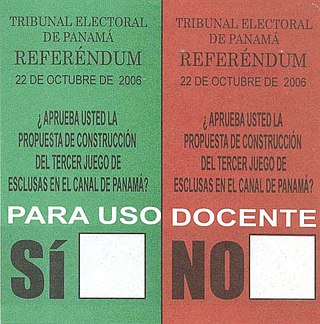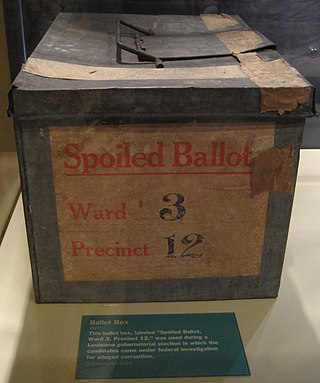
Approval voting is an electoral system in which voters can select any number of candidates instead of selecting only one.
Score voting, sometimes called range voting or average score voting, is an electoral system for single-seat elections. Voters give each candidate a numerical score, and the candidate with the highest average score is elected. Score voting includes the well-known approval voting, but also lets voters give partial (in-between) approval ratings to candidates.
Strategic or tactical voting is a situation where a voter considers the possible ballots cast by other voters in order to maximize their satisfaction with the election's results. For example, in plurality or instant-runoff, a voter may recognize their favorite candidate is unlikely to win and so instead support a candidate they think is more likely to win.

A Condorcet method is an election method that elects the candidate who wins a majority of the vote in every head-to-head election against each of the other candidates, whenever there is such a candidate. A candidate with this property, the pairwise champion or beats-all winner, is formally called the Condorcet winner. The head-to-head elections need not be done separately; a voter's choice within any given pair can be determined from the ranking.

Voting is a method by which a group, such as a meeting or an electorate, convenes together for the purpose of making a collective decision or expressing an opinion usually following discussions, debates or election campaigns. Democracies elect holders of high office by voting. Residents of a jurisdiction represented by an elected official are called "constituents", and the constituents who choose to cast a ballot for their chosen candidate are called "voters." There are different systems for collecting votes, but while many of the systems used in decision-making can also be used as electoral systems, any which cater to proportional representation can only be used in elections.
Disapproval voting is any electoral system that allows many voters to express formal disapproval simultaneously, in a system where they all share some power. Unlike most electoral systems, it requires that only negative measures or choices be presented to the voter or representative. If used to select candidates for an office, or for continuation to a next round of voting or play, it is either single- or multi-winner, as everyone who is not disapproved of is in effect a winner, for that round.

A protest vote is a vote cast in an election to demonstrate dissatisfaction with the choice of candidates or the current political system. Protest voting takes a variety of forms and reflects numerous voter motivations, including political apathy. Where voting is compulsory, casting a blank vote is available for those who do not wish to choose a candidate, or to protest. Unlike abstention elsewhere, blank votes are counted.
The majority criterion is a voting system criterion. The criterion states that "if only one candidate is ranked first by a majority of voters, then that candidate must win."
In single-winner voting system theory, the Condorcet loser criterion (CLC) is a measure for differentiating voting systems. It implies the majority loser criterion but does not imply the Condorcet winner criterion.
Majority judgment (MJ) is a single-winner voting system proposed in 2010 by Michel Balinski and Rida Laraki. It is a kind of highest median rule, a cardinal voting system that elects the candidate with the highest median rating.

Rated voting refers to any electoral system which allows the voter to give each candidate an independent evaluation, typically a rating or grade. These are also referred to as cardinal, evaluative, or graded voting systems. Cardinal methods and ordinal methods are the two modern categories of voting systems.
A unified primary is an electoral system for narrowing the field of candidates for a single-winner election, similar to a nonpartisan blanket primary, but using approval voting for the first round, advancing the top-two candidates, allowing voters to confirm the majority-supported candidate in the general election.
Satisfaction approval voting (SAV), also known as equal and even cumulative voting, is an electoral system that is a form of multiwinner approval voting as well as a form of cumulative voting. In the academic literature, the rule was studied by Steven Brams and Marc Kilgour in 2010. In this system, voters may approve a number of candidates, and each approved candidate receives an equal fraction of the vote. For example, if a voter approves 4 candidates, then each candidate receives a 0.25 fractional vote. The election winners are those candidates that receive the highest fractional vote count.
Proportional approval voting (PAV) is a proportional electoral system for multiwinner elections. It is a multiwinner approval method that extends the highest averages method of apportionment commonly used to calculate apportionments for party-list proportional representation. However, PAV allows voters to support only the candidates they approve of, rather than being forced to approve or reject all candidates on a given party list.

Sequential proportional approval voting (SPAV) or reweighted approval voting (RAV) is an electoral system that extends the concept of approval voting to a multiple winner election. It is a simplified version of proportional approval voting. It is a special case of Thiele's voting rules, proposed by Danish statistician Thorvald N. Thiele in the early 1900s. It was used in Sweden for a short period from 1909-1921, and was replaced by a cruder "party-list" style system as it was easier to calculate.
An approval ballot, also called an unordered ballot, is a ballot in which a voter may vote for any number of candidates simultaneously, rather than for just one candidate. Candidates that are selected in a voter's ballot are said to be approved by the voter; the other candidates are said to be disapproved or rejected. Approval ballots do not let the voters specify a preference-order among the candidates they approve; hence the name unordered. This is in contrast to ranked ballots, which are ordered. There are several electoral systems that use approval balloting; they differ in the way in which the election outcome is determined:
A major branch of social choice theory is devoted to the comparison of electoral systems, otherwise known as social choice functions. Viewed from the perspective of political science, electoral systems are rules for conducting elections and determining winners from the ballots cast. From the perspective of economics, mathematics, and philosophy, a social choice function is a mathematical function that determines how a society should make choices, given a collection of individual preferences.
The highest median voting rules are a class of graded voting rules where the candidate with the highest median rating is elected.
In political science and social choice theory, the spatialmodel of voting is a mathematical model of voting behavior. It describes voters and candidates as varying along one or more axes, where each axis represents an attribute of the candidate that voters care about. Voters are modeled as having an ideal point in this space and voting for the candidates closest to them.
Round-robin voting refers to a set of ranked voting systems that elect winners by comparing all candidates in a round-robin tournament. Every candidate is matched up against every other candidate, where their point total is equal to the number of votes they receive; the method then selects a winner based on the results of these paired matchups.







